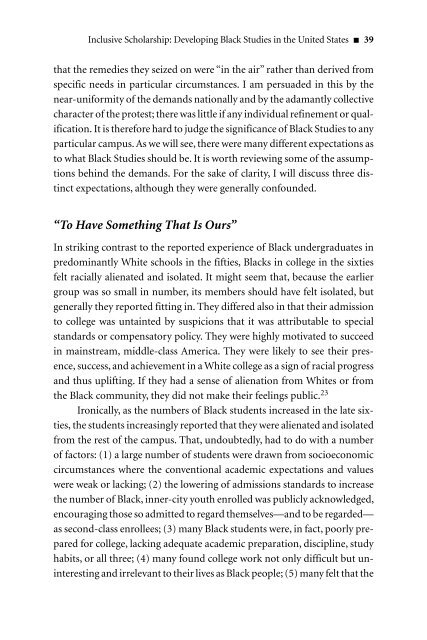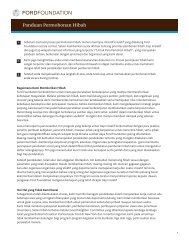Inclusive Scholarship: Developing Black Studies - Ford Foundation
Inclusive Scholarship: Developing Black Studies - Ford Foundation
Inclusive Scholarship: Developing Black Studies - Ford Foundation
You also want an ePaper? Increase the reach of your titles
YUMPU automatically turns print PDFs into web optimized ePapers that Google loves.
<strong>Inclusive</strong> <strong>Scholarship</strong>: <strong>Developing</strong> <strong>Black</strong> <strong>Studies</strong> in the United States 39<br />
that the remedies they seized on were “in the air” rather than derived from<br />
specific needs in particular circumstances. I am persuaded in this by the<br />
near-uniformity of the demands nationally and by the adamantly collective<br />
character of the protest; there was little if any individual refinement or qualification.<br />
It is therefore hard to judge the significance of <strong>Black</strong> <strong>Studies</strong> to any<br />
particular campus. As we will see, there were many different expectations as<br />
to what <strong>Black</strong> <strong>Studies</strong> should be. It is worth reviewing some of the assumptions<br />
behind the demands. For the sake of clarity, I will discuss three distinct<br />
expectations, although they were generally confounded.<br />
“To Have Something That Is Ours”<br />
In striking contrast to the reported experience of <strong>Black</strong> undergraduates in<br />
predominantly White schools in the fifties, <strong>Black</strong>s in college in the sixties<br />
felt racially alienated and isolated. It might seem that, because the earlier<br />
group was so small in number, its members should have felt isolated, but<br />
generally they reported fitting in. They differed also in that their admission<br />
to college was untainted by suspicions that it was attributable to special<br />
standards or compensatory policy. They were highly motivated to succeed<br />
in mainstream, middle-class America. They were likely to see their presence,<br />
success, and achievement in a White college as a sign of racial progress<br />
and thus uplifting. If they had a sense of alienation from Whites or from<br />
the <strong>Black</strong> community, they did not make their feelings public. 23<br />
Ironically, as the numbers of <strong>Black</strong> students increased in the late sixties,<br />
the students increasingly reported that they were alienated and isolated<br />
from the rest of the campus. That, undoubtedly, had to do with a number<br />
of factors: (1) a large number of students were drawn from socioeconomic<br />
circumstances where the conventional academic expectations and values<br />
were weak or lacking; (2) the lowering of admissions standards to increase<br />
the number of <strong>Black</strong>, inner-city youth enrolled was publicly acknowledged,<br />
encouraging those so admitted to regard themselves—and to be regarded—<br />
as second-class enrollees; (3) many <strong>Black</strong> students were, in fact, poorly prepared<br />
for college, lacking adequate academic preparation, discipline, study<br />
habits, or all three; (4) many found college work not only difficult but uninteresting<br />
and irrelevant to their lives as <strong>Black</strong> people; (5) many felt that the

















